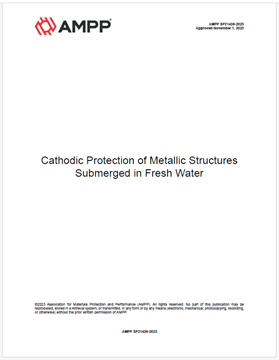Search
Standards
View as
Sort by
Display
per page
AMPP SP03-30-2022, Treatments for the Protection for Metal Parts of Service Stores and Equipment Against Corrosion
Product Number:
AMPP SP03-30-2022
Publication Date:
2022
$109.00
AMPP SP21417-2023, Performance Requirements for Navy Ships Exterior Topside Coatings
Product Number:
AMPP SP21417-2023
Publication Date:
2023
$109.00
AMPP SP21438-2023, Cathodic Protection of Metallic Structures Submerged in Fresh Water
Product Number:
AMPP SP21438-2023
Publication Date:
2023
$109.00
AMPP SP21443-2021, Coating Systems (External) for Pipeline Trenchless Crossings
Product Number:
AMPP SP21443-2021
Publication Date:
2021
$109.00
AMPP SP21460-2022, Corrosion Control of Pilings in Non-marine Applications
Product Number:
AMPP SP21460-2022
Publication Date:
2022
$109.00
AMPP SP21466-2024, Materials Sustainability Framework Based on Corrosion Management System
Product Number:
AMPP SP21466-2024
Publication Date:
2024
$109.00
AMPP SP21474-2023, External Corrosion Control of On-Grade Carbon Steel Storage Tank Bottoms
Product Number:
AMPP SP21474-2023
Publication Date:
2023
$109.00
AMPP SP21481-2022, Maintenance Overcoating of Railcar Exteriors
Product Number:
AMPP SP21481-2022
Publication Date:
2022
$109.00
AMPP SP21484-2023, Splash Zone Site-Applied Wrap Corrosion Protection Systems
Product Number:
AMPP SP21484-2023
Publication Date:
2023
$109.00
AMPP SP21485-2022, Citric Acid-Based Passivation of Maritime Stainless Steel Storage Tanks
Product Number:
AMPP SP21485-2022
Publication Date:
2022
$109.00
AMPP SP21486-2023, Dry-Docking Hull Surface Maintenance and Repair Standard Practice
Product Number:
AMPP SP21486-2023
Publication Date:
2023
$109.00
AMPP SP21487-2021, Inspecting and Reporting Biofouling and Antifouling Systems’ Condition during Underwater Inspections on Ships
Product Number:
AMPP SP21487-2021
Publication Date:
2021
$109.00













